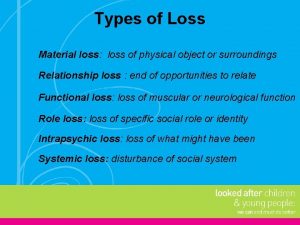Clinical Decisionmaking GRADUAL VISUAL LOSS Gradual Visual loss












- Slides: 12

Clinical Decision-making GRADUAL VISUAL LOSS

Gradual Visual loss A 66 -year-old man attended his general practitioner (GP) complaining of a painless gradual fall in vision, worse in the right eye than the left, over the preceding six months. Apart from needing spectacles for close work, he had experienced no eye problems in the past.

Gradual Visual loss He was known to be hypertensive, but this was well controlled with diuretic tablets. His GP had advised him to consult an ophthalmologist , who was unable to improve the visual acuity by changing his glasses. Q 1: List the major diagnostic possibilities.

Gradual Visual loss

Scenario 1 The patient had been experiencing increasing difficulty with vision for both near and distance. Bright light caused severe glare. He had to stop driving.

Scenario 1 The ophthalmologist found that the patient was more shortsighted than at a previous examination twelve months ago. Q 2: What is the most likely diagnosis, and why?

Scenario 1 Q 3: What physical sign is demonstrated here What other simple tests could be performed to assess further the nature and severity of the problem?

Scenario 1 Q 4: What management would you recommend? What is the prognosis?

Scenario 2 The patient was beginning to fail to notice objects and people approaching from the side. When crossing the road, he had to turn his head to be sure of seeing approaching traffic. Q 5: What diagnosis would you consider? Q 6: What other tests are important?

Scenario 2 Right Left Q 7: These are the patient's optic discs Describe what you see.

Scenario 2 Intraocular pressure was 30 mm Hg in the right eye, and 28 mm Hg in the left. Gonioscopy showed wide open anterior chamber angles in both eyes. Q 8: List the treatment options

Thank You
 Survey of household economics and decisionmaking
Survey of household economics and decisionmaking Fluid mechanics
Fluid mechanics Normal loss treatment in process costing
Normal loss treatment in process costing The gradual change in living communities
The gradual change in living communities The gradual change in a species over time
The gradual change in a species over time A substituição ordenada e gradual
A substituição ordenada e gradual Gradual release of responsibility pedagogy
Gradual release of responsibility pedagogy Natural selection definition biology
Natural selection definition biology Body effect coefficient
Body effect coefficient The gradual development of a community over time
The gradual development of a community over time Similar pictures
Similar pictures A gradual change in a community over time.
A gradual change in a community over time. Plan gradual de cumplimiento
Plan gradual de cumplimiento























